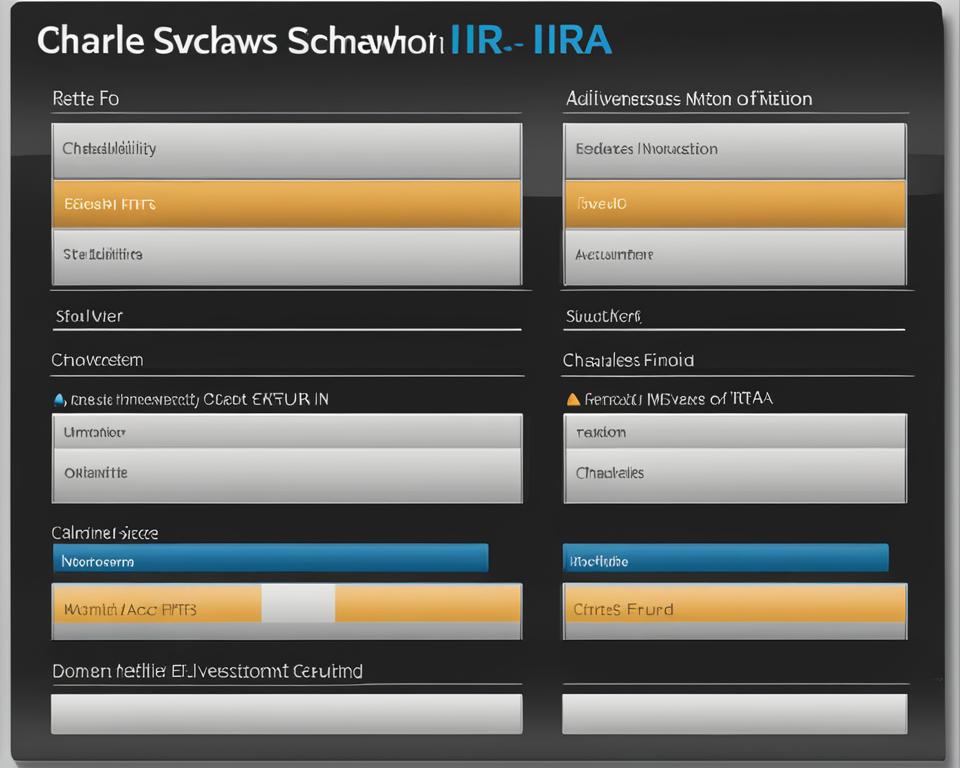Are you looking for a tax-efficient way to save for retirement? Consider opening a Charles Schwab Roth IRA. With a Charles Schwab Roth IRA, you can enjoy tax-free growth and flexible retirement planning. It’s never too early or too late to start saving for your future, so why not open your 2023 Roth IRA before April 15, 2024?
A Roth IRA can be a smart savings option, especially if you expect to be in a higher tax bracket in the future. The contributions you make to a Roth IRA are made with after-tax dollars, meaning that you’ve already paid taxes on the money. However, the real benefit comes when you start withdrawing the funds during retirement. Unlike traditional IRAs, where withdrawals are subject to income tax, qualified withdrawals from a Roth IRA can be taken out tax-free and penalty-free once you are 59½ years old and have met the minimum account holding period of five years.
Another advantage of a Roth IRA is that there are no mandatory withdrawals. This means that you can let your money grow tax-free for as long as you want, giving it the potential to accumulate even more wealth over time. Additionally, Roth IRAs can be passed on to your heirs, who can continue to enjoy tax-free withdrawals from the inherited account.
Key Takeaways:
- Open a Charles Schwab Roth IRA for tax-free growth and flexible retirement planning.
- Contributions to a Roth IRA are made with after-tax dollars.
- Qualified withdrawals from a Roth IRA are tax-free and penalty-free after age 59½ and a minimum account holding period of five years.
- Roth IRAs have no mandatory withdrawals.
- Inherited Roth IRAs can provide tax-free withdrawals for heirs.
Start planning for a secure retirement by opening a Charles Schwab Roth IRA today. The tax benefits and potential for tax-free growth can make a significant difference in your future financial well-being. Take advantage of this opportunity and begin your journey towards a worry-free retirement with Charles Schwab.
Why Open a Roth IRA?
A Roth IRA can be a beneficial retirement savings option for those who anticipate being in a higher tax bracket in the future. Contributions made to a Roth IRA are after-tax, which means that the money has already been taxed. This allows for potential tax-free growth and tax-free withdrawals during retirement.
Roth IRAs provide flexibility, as there are no mandatory withdrawals, unlike traditional IRAs.
Inherited Roth IRAs also offer tax advantages, with tax-free withdrawals for heirs.
“A Roth IRA is a powerful tool in retirement planning because it allows individuals to contribute after-tax dollars and potentially enjoy tax-free growth and withdrawals in the future.”
The Benefits of a Roth IRA
Opening a Roth IRA offers several key advantages:
- Tax-Free Growth: With a Roth IRA, you have the potential for tax-free growth on your investments. This means that any earnings or gains within the account are not subject to federal income tax, allowing your account balance to increase over time.
- Tax-Free Withdrawals: In retirement, you can make tax-free withdrawals from your Roth IRA. Unlike traditional IRAs, which require you to pay income tax on withdrawals, Roth IRA withdrawals are generally tax-free as long as you meet certain criteria.
- Flexibility: Roth IRAs offer more flexibility than traditional IRAs. There are no required minimum distributions (RMDs), which means you can let your investments grow for as long as you like. Additionally, Roth IRAs allow you to contribute at any age, as long as you have qualifying earned income.
By taking advantage of these benefits, a Roth IRA can play a crucial role in your retirement planning strategy, helping you secure a tax-efficient and comfortable retirement.
Inherited Roth IRAs and Tax Advantages
One of the unique features of Roth IRAs is their potential to provide tax advantages for heirs. When you pass away and designate your Roth IRA to a beneficiary, they can inherit the account and enjoy tax-free withdrawals.
This means that your loved ones can receive the funds from your Roth IRA without having to pay federal income tax. For individuals who want to leave a tax-free legacy to their heirs, a Roth IRA can be an effective estate planning tool.
Benefits of a Roth IRA
Roth IRAs offer numerous advantages for retirement planning, making them an attractive option for long-term savings. Whether you’re just starting your career, in the middle of your retirement journey, or approaching your golden years, a Roth IRA can provide flexibility and financial security.
Growth Potential and Tax-Free Accumulation
One of the key benefits of a Roth IRA is the potential for tax-free growth on your investments. Contributions and potential investment gains within your Roth IRA accumulate tax-free over time. This means that you won’t have to pay taxes on the growth of your investments when you withdraw the funds during retirement.
To put it simply, every dollar you invest in a Roth IRA has the potential to grow tax-free and can provide significant benefits in the long run. Unlike with traditional IRAs, where your withdrawals are typically taxed, a Roth IRA allows you to keep more of your hard-earned money.
Tax-Free Withdrawals in Retirement
Another major advantage of a Roth IRA is the ability to make tax-free withdrawals during retirement. Once you reach the age of 59½ and have held your Roth IRA for at least five years, qualified withdrawals can be taken out tax-free and penalty-free. This means that the money you withdraw from your Roth IRA will be entirely yours to enjoy without any tax implications.
Retirement should be a time of relaxation and enjoyment, and a Roth IRA can help ensure that you have the financial freedom to do so. Whether you have dreams of traveling the world, pursuing hobbies, or spending quality time with loved ones, a Roth IRA can provide the means to make those dreams a reality.
Flexibility and Contributions at Any Age
Unlike some retirement savings accounts, there are no age restrictions for contributing to a Roth IRA as long as you have qualifying earned income. Whether you’re in your twenties, thirties, or beyond, you can start investing in a Roth IRA at any stage of your life.
This flexibility allows you to take control of your retirement planning and start building a nest egg whenever you’re ready. It’s never too late to start saving for the future, and a Roth IRA provides the opportunity to do so on your own terms.
Quote
“A Roth IRA offers the unique advantage of tax-free growth and tax-free withdrawals in retirement. It’s a powerful way to secure your financial future and enjoy the fruits of your labor without the burden of unnecessary taxes.”
– Financial Advisor
In summary, a Roth IRA offers significant benefits for retirement planning. With tax-free growth potential, the ability to make tax-free withdrawals during retirement, and the flexibility to contribute at any age, a Roth IRA is a valuable tool for building a secure financial future. Take advantage of these benefits and start investing in a Roth IRA today to ensure a comfortable and enjoyable retirement.
Eligibility for a Roth IRA
In order to open a Roth IRA, your eligibility and the maximum contribution amount are determined by your Modified Adjusted Gross Income (MAGI). Here’s an overview of the guidelines:
For tax year 2023:
- Single filers can contribute the maximum amount if their MAGI is below $138,000.
- Joint filers can contribute the maximum amount if their MAGI is below $218,000.
- Contribution limits start to reduce for single filers at $138,000 and for joint filers at $218,000.
For tax year 2024:
- Single filers can contribute the maximum amount if their MAGI is below $146,000.
- Joint filers can contribute the maximum amount if their MAGI is below $230,000.
- Contribution limits start to reduce for single filers at $146,000 and for joint filers at $230,000.
It is important to consult the Roth IRA vs. Traditional IRA Calculator to determine your eligibility for different IRA options based on your MAGI. This will help you make an informed decision regarding your retirement savings strategy.
How to Open a Roth IRA Account
Opening a Roth IRA account with Charles Schwab is a simple process that can be done online. Follow these steps to start benefiting from tax-free growth and flexible retirement planning:
- Choose the type of IRA account. Opt for a Roth IRA account.
- Provide personal, employment, and financial information. Fill in the necessary details accurately and verify the information.
- Select specific account features. Tailor your account to meet your retirement goals.
- Create login credentials. Choose a secure username and password for your account.
- Verify identity. Complete the necessary identity verification process.
- Indicate funding preferences. Decide how you want to fund your Roth IRA account.
- Review and submit the application. Double-check all the information and submit your application.
Once your Charles Schwab Roth IRA account is opened, you can enjoy the benefits of tax-free growth and make investment decisions that align with your retirement goals. Start planning for a secure financial future today!
Benefits of Converting to a Roth IRA
A Roth IRA conversion presents a valuable opportunity to transfer your retirement savings from a Traditional IRA, SEP IRA, SIMPLE IRA, or 401(k) into a Roth IRA. Unlike other retirement accounts, Roth IRA conversions have no age limitations, allowing individuals of any age to take advantage of the unique benefits offered by a Roth IRA. Even if your current income disqualifies you from making additional Roth IRA contributions, a conversion enables you to seize the advantages of tax-free growth and tax-free withdrawals during retirement.
One key advantage of converting to a Roth IRA is the potential for tax-free growth. With a Roth IRA, your investments have the opportunity to grow over time without being subject to taxation. This can result in significant savings in the long run and enhance the overall value of your retirement savings.
Another benefit is the ability to make tax-free withdrawals during retirement. Unlike some other retirement accounts, qualified distributions from a Roth IRA can be taken out tax-free. This means that when it comes time to access your retirement savings, you won’t have to worry about paying taxes on the funds you withdraw.
“By converting to a Roth IRA, individuals can benefit from tax-free growth and tax-free withdrawals during retirement.”
It is important to note that the IRS eliminated income restrictions on Roth IRA conversions starting from January 1, 2010. This means that regardless of your income level, you have the opportunity to convert to a Roth IRA and enjoy the potential tax advantages it offers.
Converting to a Roth IRA can be a strategic move for individuals looking to optimize their retirement savings. By taking advantage of the tax-free growth and tax-free withdrawals, you can potentially maximize the value of your retirement funds and enjoy greater financial security in your golden years.
Benefits of Converting to a Roth IRA:
- Potential for tax-free growth
- Opportunity for tax-free withdrawals during retirement
- No income restrictions on Roth IRA conversions since January 1, 2010
Example Table: Comparison of Retirement Accounts
| Retirement Account | Tax Treatment of Contributions | Tax Treatment of Earnings | Tax Treatment of Withdrawals |
|---|---|---|---|
| Roth IRA | Contributions are made with after-tax dollars | Earnings grow tax-free | Qualified withdrawals are tax-free |
| Traditional IRA | Contributions may be tax-deductible | Earnings grow tax-deferred | Withdrawals are taxed as ordinary income |
| 401(k) | Contributions may be tax-deductible | Earnings grow tax-deferred | Withdrawals are taxed as ordinary income |
Please note: This table is for illustrative purposes only and does not constitute financial advice. Consult with a qualified financial advisor for personalized recommendations.
Features of a Charles Schwab Roth IRA
When it comes to securing your financial future through retirement planning, a Charles Schwab Roth IRA offers a range of features that can help you achieve your goals. With a Charles Schwab Roth IRA, you have access to:
- A wide range of investment options including stocks, bonds, ETFs, mutual funds, and CDs.
- Professional portfolio management solutions to make investing easier and more effective.
- Tools, education, and assistance to help you feel confident and comfortable in your retirement planning journey.
- No minimum deposit requirement, allowing you to start investing in your Roth IRA with ease.
- $0 online listed equity trade commissions, reducing costs and maximizing your investment potential.
With these features, a Charles Schwab Roth IRA provides you with the flexibility and opportunities for tax-free growth, ensuring that your retirement savings work hard for you.

Tax Benefits and Withdrawal Rules of a Roth IRA
A Roth IRA offers several tax benefits that can greatly enhance your retirement planning. While contributions to a Roth IRA are not tax-deductible, the earnings within the account grow tax-free. This means that you won’t have to pay taxes on the investment gains you make over time.
One of the key advantages of a Roth IRA is the ability to make qualified withdrawals tax-free. After the account has been open for five years and you have reached the age of 59½, you can withdraw your funds without owing any taxes on the amount withdrawn.
However, what sets a Roth IRA apart from traditional IRAs is its flexibility in terms of withdrawals. There are certain circumstances where you can make tax-free withdrawals before age 59½. For example, if you’re a first-time homebuyer, you can use funds from your Roth IRA towards the purchase of your home without incurring any taxes or penalties. Similarly, qualified higher education expenses and certain medical expenses can also be funded with tax-free withdrawals from your Roth IRA.
Another advantage of a Roth IRA is that it does not require minimum distributions. Unlike traditional IRAs, which mandate that you start taking required minimum distributions (RMDs) once you reach a certain age, Roth IRAs allow you to let your money grow tax-free for as long as you like. This gives you more control over your retirement planning and the flexibility to withdraw funds only when you need them.
“Contributions to a Roth IRA are not tax-deductible, but the tax-free growth and tax-free withdrawals during retirement make it a valuable savings tool.”
Having a Roth IRA can provide you with peace of mind knowing that your retirement savings can be accessed tax-free when you need them. Whether it’s for your dream home, your child’s education, or unexpected medical expenses, a Roth IRA gives you the freedom to use your funds without worrying about a hefty tax bill.
Investment Choices for Roth IRAs
When it comes to planning for your retirement with a Roth IRA, one of the key considerations is choosing the right investments to grow your savings over time. Roth IRAs offer a wide range of investment choices that can help you achieve your financial goals. Whether you prefer stocks, bonds, ETFs, mutual funds, CDs, or other investment options, a Roth IRA allows you the flexibility to diversify your portfolio and take advantage of potential market opportunities.
As a leading provider of retirement accounts, Charles Schwab offers professional investment advice and guidance to help you make informed decisions regarding your Roth IRA. By consulting with a Schwab investment professional, you can receive personalized recommendations based on your specific needs and goals. They can assist you in selecting the investment choices that align with your risk tolerance and time horizon, ensuring that your retirement savings are on track.
In addition to personalized advice, Charles Schwab provides a wealth of resources to help you navigate your investment choices. They offer planning calculators that can help you assess your risk tolerance, set realistic retirement goals, and determine the optimal mix of investments for your portfolio. Their market commentary keeps you informed about the latest market trends, helping you make informed decisions based on current economic conditions.
“The key to a successful Roth IRA investment strategy is to diversify your portfolio and stay disciplined in your approach. By spreading your investments across different asset classes, you can manage risk and potentially maximize returns over the long term.” – Charles Schwab
By utilizing the investment choices available to you within a Roth IRA, you can position yourself for long-term growth and a secure retirement. To learn more about the investment options and services offered by Charles Schwab, visit their website or contact one of their investment professionals.
Contribution Limits and Income Eligibility for Roth IRAs
When it comes to contributing to a Roth IRA, it’s important to be aware of the contribution limits and income eligibility requirements. Understanding these factors will help you make informed decisions and maximize your retirement savings.
Contribution Limits
The contribution limits for Roth IRAs vary based on the tax year. For tax year 2023, the maximum contribution is $6,500. However, individuals aged 50 and older can make an additional catch-up contribution of $1,000, bringing their total contribution limit to $7,500. For tax year 2024, the limits increase to $7,000 and $8,000, respectively.
To illustrate the contribution limits, here’s a table summarizing the maximum contribution amounts:
| Tax Year | Contribution Limit | Catch-Up Contribution (Age 50+) |
|---|---|---|
| 2023 | $6,500 | $1,000 |
| 2024 | $7,000 | $1,000 |
Income Eligibility
In addition to contribution limits, income eligibility requirements determine who can contribute to a Roth IRA. For tax year 2023, single individuals with a Modified Adjusted Gross Income (MAGI) above $153,000 and joint filers with MAGI above $228,000 may be ineligible to contribute to a Roth IRA. The limits increase for tax year 2024, with single individuals starting to reduce their contribution limit at $161,000 and joint filers starting at $240,000.
Here’s a table illustrating the income eligibility thresholds:
| Tax Year | Single Filers (MAGI) | Joint Filers (MAGI) |
|---|---|---|
| 2023 | Above $153,000 | Above $228,000 |
| 2024 | Above $161,000 | Above $240,000 |
It’s important to keep in mind that these income eligibility requirements can impact your ability to contribute to a Roth IRA. It’s recommended to consult with a financial advisor or tax professional to ensure you meet the necessary criteria.

By understanding the contribution limits and income eligibility requirements for Roth IRAs, you can make strategic decisions to optimize your retirement planning. Remember to take advantage of catch-up contributions if you’re 50 or older and consult with professionals for personalized advice.
Considerations and Rules for Roth IRAs
When it comes to Roth IRAs, there are certain considerations and rules that you should keep in mind for effective retirement planning. Understanding these rules can help you make informed decisions and maximize the benefits of your Roth IRA.
Contributions and Tax Benefits
Contributing to a Roth IRA does not guarantee a current-year tax deduction. However, it offers the advantage of tax-free growth and tax-free withdrawals in the future. This means that you can potentially enjoy tax-free earnings on your investments and withdraw your funds without incurring additional taxes during retirement.
Unlike traditional IRAs and 401(k) plans, which offer tax-deductible contributions but taxable withdrawals, Roth IRAs provide tax-free growth and tax-free withdrawals, making them a valuable option for long-term retirement savings.
Contribution Limits
It’s important to keep track of the contribution limits for Roth IRAs. For tax year 2023, the maximum contribution is $6,500, with an additional catch-up contribution of $1,000 for individuals aged 50 and older. The contribution limits increase to $7,000 for tax year 2024.
However, it’s crucial to note that these contribution limits are subject to income eligibility requirements. Depending on your Modified Adjusted Gross Income (MAGI), you may be ineligible to contribute the full amount or contribute at all. It’s essential to consult IRS guidelines and the Roth IRA vs. Traditional IRA Calculator to determine your eligibility.
Withdrawal Rules
While Roth IRAs offer the flexibility of tax-free withdrawals during retirement, there are rules surrounding when and how you can access your funds. Generally, withdrawals taken before age 59½ may be subject to both taxes and penalties.
However, there are some exceptions to this rule. Roth IRA withdrawals can be made penalty-free before age 59½ under certain circumstances, such as for first-time home purchases, higher education expenses, and certain medical expenses.
It’s essential to consult with a qualified tax advisor or financial planner to understand the specific rules and implications of Roth IRA contributions and withdrawals based on your individual situation.
Consult an Expert
Considering the complexity of retirement planning and the nuances of Roth IRA rules, it’s highly recommended to consult with a qualified tax advisor or financial planner. They can provide personalized guidance tailored to your specific needs and help you make informed decisions regarding your Roth IRA contributions, withdrawals, and overall retirement strategy.
By understanding the considerations and rules associated with Roth IRAs, you can optimize your retirement savings and work towards a secure financial future.
| Considerations and Rules for Roth IRAs | |
|---|---|
| Contributions | Tax-free growth and tax-free withdrawals |
| Contribution Limits |
|
| Withdrawal Rules |
|
Conclusion
When it comes to retirement planning, opening a Charles Schwab Roth IRA can be a smart move. It offers the benefits of tax-free growth and the ability to make tax-free withdrawals during retirement, giving you more control over your financial future. With a wide range of tools, education, and investment options, Charles Schwab provides the resources you need to make informed decisions and reach your retirement goals.
By understanding the contribution limits, income eligibility requirements, and withdrawal rules of a Roth IRA, you can maximize the benefits it has to offer. Whether you’re just starting your career or nearing retirement, a Roth IRA can provide flexibility and potential long-term savings benefits. Take advantage of the opportunity to grow your wealth and secure your financial well-being.
With Charles Schwab, you can open a Roth IRA account and take advantage of the tax-free growth and retirement planning benefits it offers. Start planning for a secure and prosperous future today with a Charles Schwab Roth IRA.
FAQ
What are the benefits of opening a Charles Schwab Roth IRA?
By opening a Charles Schwab Roth IRA, you can enjoy tax-free growth and flexible retirement planning.
Why should I open a Roth IRA?
A Roth IRA can be a good savings option, especially if you expect to be in a higher tax bracket in the future. It offers tax-free growth and tax-free withdrawals during retirement.
What are the benefits of a Roth IRA?
A Roth IRA provides flexibility with no mandatory withdrawals, offers tax-free growth, and allows for tax-free withdrawals during retirement. It can also provide tax-free withdrawals for heirs.
Who is eligible for a Roth IRA?
Individuals of any age can contribute to a Roth IRA as long as they have a qualifying earned income. The eligibility and contribution limits are based on the Modified Adjusted Gross Income (MAGI).
How do I open a Roth IRA account?
You can open a Roth IRA account with Charles Schwab by completing a simple online application process.
What are the benefits of converting to a Roth IRA?
Converting to a Roth IRA allows you to benefit from tax-free growth and tax-free withdrawals during retirement. It is a valuable option, even if your current income disqualifies you from making additional contributions.
What features does Charles Schwab offer for Roth IRA accounts?
Charles Schwab offers a wide range of investment options, professional portfolio management solutions, and tools and education to help with retirement planning.
What are the tax benefits and withdrawal rules of a Roth IRA?
Contributions to a Roth IRA are not tax-deductible, but earnings within the account grow tax-free. Qualified withdrawals can be made tax-free after five years and once the account holder is 59½ years old.
What investment choices are available for Roth IRAs?
Roth IRAs offer a variety of investment options, including stocks, bonds, ETFs, mutual funds, and CDs.
What are the contribution limits and income eligibility for Roth IRAs?
The contribution limits for 2023 are ,500 (,000 for individuals aged 50 and older) and increase for 2024. The eligibility is determined by the Modified Adjusted Gross Income (MAGI).
What considerations and rules do I need to know about Roth IRAs?
It is important to understand that contributions are not tax-deductible, excess contributions may have penalties and taxes, and early withdrawals may be subject to penalties and taxes, with certain exceptions.
What are the key benefits of opening a Charles Schwab Roth IRA?
Opening a Charles Schwab Roth IRA offers tax-free growth, flexible retirement planning, and the ability to take advantage of various Roth IRA benefits.





